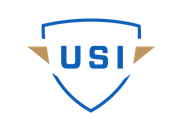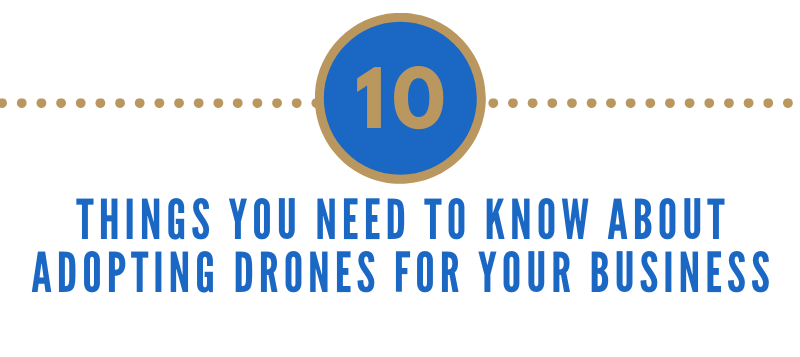Realtors, engineers, architects, ocean scientists, farmers and inspectors are all using drones to enhance their ability to do their jobs and in today’s competitive environment, it has become more and more important to adopt each new tool of the trade. The challenge is that there are few references on how to set up an enterprise drone operation, especially one covering the pitfalls you want to avoid.
Unmanned Safety Institute, the most widely recognized leader in unmanned flight safety solutions and training, gathered its top 10 lessons on how to learn about, create, and deploy drones in any operation. 1 -- Use a Reputable SourceThe first step in the process is to gain knowledge about the technology, its applications, and regulatory requirements. Without this knowledge you will not be prepared to make even basic decisions about your UAS program. This can be accomplished through formal training programs, research, or hiring a subject matter expert who can help you develop a program that fits your personalized needs. Because this is such a new industry, there are many self-identified “experts”, making it important to hire someone who can weave together their knowledge of the drone ecosystem with your company needs. You should be looking for someone who has a thorough knowledge of how regulations will affect your operations as well as an expert who can help you obtain the right clearances for your mission.
1 -- Use a Reputable SourceThe first step in the process is to gain knowledge about the technology, its applications, and regulatory requirements. Without this knowledge you will not be prepared to make even basic decisions about your UAS program. This can be accomplished through formal training programs, research, or hiring a subject matter expert who can help you develop a program that fits your personalized needs. Because this is such a new industry, there are many self-identified “experts”, making it important to hire someone who can weave together their knowledge of the drone ecosystem with your company needs. You should be looking for someone who has a thorough knowledge of how regulations will affect your operations as well as an expert who can help you obtain the right clearances for your mission. 2 – Define the MissionAfter gaining relevant knowledge about UAS technology, the next step is to define the mission that will be performed by UAS. The identified mission (or specific application of the UAS) will, quite literally, impact every facet of a business’s UAS ecosystem, including the type of UAS required, the experience and qualifications of the pilot and crew and compliance with aviation regulations.For example, a realtor who decides to use UAS to take pictures of houses for sale will only need a small quadcopter, minimal pilot training and experience. On the other hand, a government agency that wants to use UAS to monitor large wildland fires will need a very complex aircraft, highly trained crews, and the ability to operate in airspace that does not yet have the technology or regulations to adapt to unmanned aircraft operations.
2 – Define the MissionAfter gaining relevant knowledge about UAS technology, the next step is to define the mission that will be performed by UAS. The identified mission (or specific application of the UAS) will, quite literally, impact every facet of a business’s UAS ecosystem, including the type of UAS required, the experience and qualifications of the pilot and crew and compliance with aviation regulations.For example, a realtor who decides to use UAS to take pictures of houses for sale will only need a small quadcopter, minimal pilot training and experience. On the other hand, a government agency that wants to use UAS to monitor large wildland fires will need a very complex aircraft, highly trained crews, and the ability to operate in airspace that does not yet have the technology or regulations to adapt to unmanned aircraft operations. 3 – Crawl, Walk, RunIt is common knowledge that the UAS market is full of opportunities; with new applications for the technology being explored every day. Entrepreneurs are flooding the market to claim their share. Whether it is a company seeking to provide commercial UAS services, or an internal operation to support existing operations, initial UAS operations should be conservative and focused. Over-promising results, to either customers or investors, could be problematic. Being conservative allows the operator to gain essential knowledge and experience that will allow them to expand as technology and markets evolve.Once the mission has been identified, the organization can properly establish a safe and effective UAS program. The steps necessary to do so include:
3 – Crawl, Walk, RunIt is common knowledge that the UAS market is full of opportunities; with new applications for the technology being explored every day. Entrepreneurs are flooding the market to claim their share. Whether it is a company seeking to provide commercial UAS services, or an internal operation to support existing operations, initial UAS operations should be conservative and focused. Over-promising results, to either customers or investors, could be problematic. Being conservative allows the operator to gain essential knowledge and experience that will allow them to expand as technology and markets evolve.Once the mission has been identified, the organization can properly establish a safe and effective UAS program. The steps necessary to do so include:- Determining UAS requirements, acquisition and maintenance
- Development of operations manuals
- Safety Management System
- Program personnel qualifications and training
 4 -- System SelectionOnce the mission is defined, the system needed to accomplish that mission must be acquired. Consider the type of aircraft needed (VTOL or fixed-wing) as well as factors such as battery/liquid fuel power, flight time endurance required, environmental factors, and system redundancy for reliability. Next, payloads must be selected to meet the mission need, such as optical cameras, LiDar, or other environmental sensors. Third, are software considerations, such as flight planning software and ability to interface with third party post-processing software. Finally, there are manufacturer considerations- How long has the company been in business, how many aircraft/systems have they delivered, do they provide training, warranty, and maintenance support. Getting the right unmanned aircraft system not only increases the chance of a successful mission, but also provides flight crews with the optimal equipment they need to operate safely.
4 -- System SelectionOnce the mission is defined, the system needed to accomplish that mission must be acquired. Consider the type of aircraft needed (VTOL or fixed-wing) as well as factors such as battery/liquid fuel power, flight time endurance required, environmental factors, and system redundancy for reliability. Next, payloads must be selected to meet the mission need, such as optical cameras, LiDar, or other environmental sensors. Third, are software considerations, such as flight planning software and ability to interface with third party post-processing software. Finally, there are manufacturer considerations- How long has the company been in business, how many aircraft/systems have they delivered, do they provide training, warranty, and maintenance support. Getting the right unmanned aircraft system not only increases the chance of a successful mission, but also provides flight crews with the optimal equipment they need to operate safely. 5 – System MaintenanceMaintenance of the system is essential to safe operations and begins with providing training to those who will be authorized to work on the system including aircraft, ground control station, and other hardware and software. Maintenance tracking software can assist with this process, especially as the complexity of the program grows, perhaps with multiple types of UAS. The ability to track maintenance data will also help improve reliability of equipment over time.
5 – System MaintenanceMaintenance of the system is essential to safe operations and begins with providing training to those who will be authorized to work on the system including aircraft, ground control station, and other hardware and software. Maintenance tracking software can assist with this process, especially as the complexity of the program grows, perhaps with multiple types of UAS. The ability to track maintenance data will also help improve reliability of equipment over time. 6 – DocumentationThe next component of an effective drone program is an operation manual. This manual contains procedures, instructions, and guidance for use by operational personnel. It should include information on operations administration and supervision; regulatory compliance; safety; training; fatigue and flight time limitations; flight operations procedures; emergency response procedures; organizational Safety Management System procedures; and communications and maintenance. It will contain standardized checklists and other mission specific forms such as Flight Risk Assessment Tools and mission reporting forms. Properly crafted, an operations manual is easy and practical to use, accurate and dependable, and creates the standard from which an organization operates their UAS.
6 – DocumentationThe next component of an effective drone program is an operation manual. This manual contains procedures, instructions, and guidance for use by operational personnel. It should include information on operations administration and supervision; regulatory compliance; safety; training; fatigue and flight time limitations; flight operations procedures; emergency response procedures; organizational Safety Management System procedures; and communications and maintenance. It will contain standardized checklists and other mission specific forms such as Flight Risk Assessment Tools and mission reporting forms. Properly crafted, an operations manual is easy and practical to use, accurate and dependable, and creates the standard from which an organization operates their UAS. 7 – Safety Management SystemAll aviation operations, whether manned or unmanned, must have a Safety Management System (SMS) to manage risk. There are four “pillars” of SMS, including: Safety Policy; Safety Risk Management; Safety Assurance; and Safety Promotion. Safety policy begins with a commitment by management that safety is an integral part of every operation. Risk management involves proactive identification of the hazards and risks of everyday operations and responding proactively by improving the processes and conditions to mitigate that risk. No UAS mission should be undertaken unless the hazards can be mitigated to an acceptable level. Such things as Flight Risk Assessment Tools are used prior to each flight to evaluate risk and document steps taken to mitigate that risk. Safety assurance is monitored by constant verification and upgrading. It is achieved through internal and external audits and on-going monitoring of corrective actions. Finally, safety promotion includes employee training and communicating hazard information and lessons learned. These concepts are scalable to any size UAS operation, large or small, basic or complex.It's important to remember that while management “owns” the Safety Management System and is responsible for developing and implementing the formal process, everyone involved in the UAS operation is responsible for safety.
7 – Safety Management SystemAll aviation operations, whether manned or unmanned, must have a Safety Management System (SMS) to manage risk. There are four “pillars” of SMS, including: Safety Policy; Safety Risk Management; Safety Assurance; and Safety Promotion. Safety policy begins with a commitment by management that safety is an integral part of every operation. Risk management involves proactive identification of the hazards and risks of everyday operations and responding proactively by improving the processes and conditions to mitigate that risk. No UAS mission should be undertaken unless the hazards can be mitigated to an acceptable level. Such things as Flight Risk Assessment Tools are used prior to each flight to evaluate risk and document steps taken to mitigate that risk. Safety assurance is monitored by constant verification and upgrading. It is achieved through internal and external audits and on-going monitoring of corrective actions. Finally, safety promotion includes employee training and communicating hazard information and lessons learned. These concepts are scalable to any size UAS operation, large or small, basic or complex.It's important to remember that while management “owns” the Safety Management System and is responsible for developing and implementing the formal process, everyone involved in the UAS operation is responsible for safety. 8 – UAS Crew RequirementsNext, minimum requirements for UAS personnel must be established. Safety focused operations are dependent on having the right people in place. This applies to managers/supervisors, remote pilots, and non-pilot aircrew. The process begins with who will manage and supervise the program. Does this person have an aviation background, UAS experience, expert in the mission to be performed, interest in new technology? Mere assignment to a position within the organization should not be a deciding factor. The same concepts apply to aircrew, but there is a greater emphasis on the operational aspects of the position. Such things as an aviation background and previous UAS experience are important factors to consider. For newly created positions, a job description should be developed that lists all the requirements.
8 – UAS Crew RequirementsNext, minimum requirements for UAS personnel must be established. Safety focused operations are dependent on having the right people in place. This applies to managers/supervisors, remote pilots, and non-pilot aircrew. The process begins with who will manage and supervise the program. Does this person have an aviation background, UAS experience, expert in the mission to be performed, interest in new technology? Mere assignment to a position within the organization should not be a deciding factor. The same concepts apply to aircrew, but there is a greater emphasis on the operational aspects of the position. Such things as an aviation background and previous UAS experience are important factors to consider. For newly created positions, a job description should be developed that lists all the requirements. 9 – Education and TrainingThe education and training of the people involved in the UAS program is critical to safe operations. There are many components to a comprehensive training program that apply to any size UAS program.Education should include:
9 – Education and TrainingThe education and training of the people involved in the UAS program is critical to safe operations. There are many components to a comprehensive training program that apply to any size UAS program.Education should include:- Ground-based education on operations to include site surveys
- UAS flight planning, FAA requirements
- The keys to safe operations including crew resource management and aeronautical decision making specific to UAS
- Initial qualification training on the specific UAS acquired
- Scenario based training to perform the identified mission
- System maintenance
- Safety system training
- Operational policy and procedures training
 10 – Third Party Safety Audit of Internal and External Service Provider OperationsDuring UAS program development, the organization should consider complying with evolving industry standards for UAS operations. ARGUS Unmanned, the Public Safety Aviation Accreditation Commission and National Fire Protection Association have developed UAS standards that organizations can use to assure the quality of their operation. Regardless, the UAS organization should regularly evaluate its operation and continually strive to improve performance. This is accomplished by conducting internal and external audits of operations. If the organization is contracting for UAS services from a commercial provider, this is particularly important. The employing organization must assure that the contractor meets all the minimum requirements for a safe operation.When combined, these factors provide the organizational support needed by the remote pilot and aircrew as they strive to provide safe and effective UAS operations.
10 – Third Party Safety Audit of Internal and External Service Provider OperationsDuring UAS program development, the organization should consider complying with evolving industry standards for UAS operations. ARGUS Unmanned, the Public Safety Aviation Accreditation Commission and National Fire Protection Association have developed UAS standards that organizations can use to assure the quality of their operation. Regardless, the UAS organization should regularly evaluate its operation and continually strive to improve performance. This is accomplished by conducting internal and external audits of operations. If the organization is contracting for UAS services from a commercial provider, this is particularly important. The employing organization must assure that the contractor meets all the minimum requirements for a safe operation.When combined, these factors provide the organizational support needed by the remote pilot and aircrew as they strive to provide safe and effective UAS operations.  About the ContributorJosh Olds has served as the President of the Unmanned Safety Institute since June 2018, when he transitioned from his role as Vice President of Operations; a position he held since the company’s inception in 2014. Josh has led the development of both industry and collegiate level content and curriculum for education and training and established the ARGUS Organizational Unmanned Industry Standard. He also serves as a member of the UAS FAA Safety Team (FAAST) and as an advisory board member for the Energy Drone Coalition. His work and impact on the unmanned industry were recognized when he received an award for Airmanship and Contribution to the UAS Industry by the Association for Unmanned Vehicles International. The Unmanned Safety Institute (USI) is the industry’s most widely recognized leader in flight safety solutions for individuals, academia, and organizations focused on integrating and operating UAS. With over 150 instructors and over 6,000 customers around the world, USI sets the global standard for scalable UAS operations. Contact USI by emailing [email protected] or calling 1-877-535-SAFE.
About the ContributorJosh Olds has served as the President of the Unmanned Safety Institute since June 2018, when he transitioned from his role as Vice President of Operations; a position he held since the company’s inception in 2014. Josh has led the development of both industry and collegiate level content and curriculum for education and training and established the ARGUS Organizational Unmanned Industry Standard. He also serves as a member of the UAS FAA Safety Team (FAAST) and as an advisory board member for the Energy Drone Coalition. His work and impact on the unmanned industry were recognized when he received an award for Airmanship and Contribution to the UAS Industry by the Association for Unmanned Vehicles International. The Unmanned Safety Institute (USI) is the industry’s most widely recognized leader in flight safety solutions for individuals, academia, and organizations focused on integrating and operating UAS. With over 150 instructors and over 6,000 customers around the world, USI sets the global standard for scalable UAS operations. Contact USI by emailing [email protected] or calling 1-877-535-SAFE.















Comments